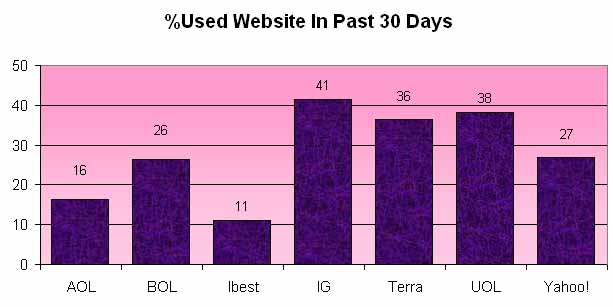
(source: 2004 TGI Brasil)
Internet Service Providers and Portals in Brazil
To access the Internet on a regular basis, one needs to find an Internet Service Provider (ISP). For our purposes here, we classify the internet service providers into two types.
The first type is a simple no-frills service. For payment of a periodic fee, the user is enabled to have access to the Internet by a number of modes (such as telephone dial-up, cable modem, DSL, etc). When the user connects to the Internet, there is no indication or identification about the Internet Service Provider itself.
The second type is an Internet Service Provider which actually has its own portal. When the user connects to the Internet, it is usually directly to the web portal of the Internet Service Provider. The web portal contains the full range of services offered by the Internet Service Provider, such as e-mail and instant messaging, as well as proprietary content material. This service may require a periodic fee payment, but it may even be free of charge.
We will now look at some survey data from the 2004 TGI Brasil study. This is a survey of 5,312 persons between the ages of 12 to 64 years old in Brazil conducted during the first half of year 2004. Within this study, 1,968 persons said that they had used the Internet in the last 30 days. The following chart shows the shares of the home-user market of the largest Internet Service Providers in Brazil.

(source: 2004 TGI Brasil)
All six of these Internet Service Providers have their own web portals. There is a financial reason for this phenomenon. After all, fully functional web portals cannot be built and maintained for nothing and only those Internet Service Providers with large number of subscribers can achieve the economies of scale. Conversely, a simple no-frills Internet Service Provider should forego the portal and hope to compete on price alone.
The reasons that a large ISP will go through the additional effort to build a portal are two-fold. First of all, this is a value-added service in that a fully functional web portal with exclusive and proprietary content will be more attractive to prospective users. Secondly, the web portal may may be a source of revenue (e.g. advertising, shopping, subscriptions, etc). In fact, a good web portal may even be a popular web destination in its own right, irrespective of whether the users are subscribers to the ISP or not.
The next chart shows the usage incidence for the web portals. In each and every case, the usage incidence is greater than the incidence of subscription to the corresponding ISP, sometimes by a lot. Across the seven IPS's, the average market share is 11%; but the average incidence of usage of the web portals is 28%.

(source: 2004 TGI Brasil)
Yet, there is still a loyalty factor for the ISP subscribers. The bottom line numbers are these. For the seven web portals here, the average incidence of usage is 28%. Across the seven ISP's, the average incidence of usage of the web portal of the ISP is 84%. It is just natural for the subscribers to use the web portals of their ISP's. Across the seven ISP's, the average incidence of usage of the web portals of the other six ISP's is 27%, or about the same as the total population. This validates the assumptions that lie behind why ISP's want to build their web portals.
(posted by Roland Soong, 10/10/2004)
(Return to Zona Latina's Home Page)